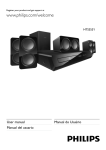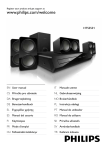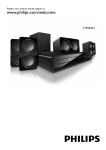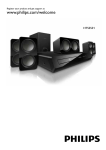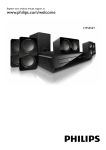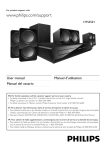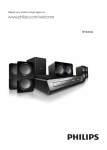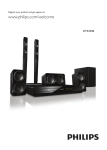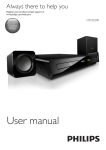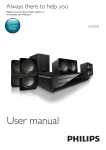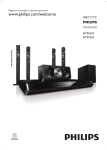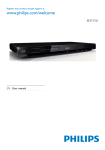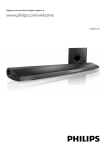Download Philips HTS3531
Transcript
Register your product and get support at www.philips.com/welcome HTS3531 User manual 用户手册 1Notice Copyright Trademarks 2Important Safety Care for your product Care of the environment 3 Your home theater Main unit Remote control 4 Connect your home theater Speakers Connectors Connect to TV Connect audio from TV and other devices 5 Use your home theater Choose sound Discs USB storage devices DivX Karaoke Audio, video, and picture options Radio MP3 player Create MP3 files EasyLink 2 2 2 3 3 4 4 4 4 5 6 6 7 8 9 6 Change settings 16 16 17 17 18 18 19 7 Update software 19 19 19 8 Product specifications 20 9Troubleshooting 22 10Index 23 Picture Sound Language Parental control Energy saving Apply factory settings Check software version Update software through USB or CD-R 10 10 10 11 11 12 13 14 14 15 15 EN 1 English Contents 1Notice This section contains the legal and trademark notices. Copyright This item incorporates copy protection technology that is protected by U.S. patents and other intellectual property rights of Rovi Corporation. Reverse engineering and disassembly are prohibited. Trademarks Manufactured under license from Dolby Laboratories. Dolby and the double-D symbol are trademarks of Dolby Laboratories. DivX , DivX Ultra , DivX Certified and associated logos are trademarks of Rovi Corporation or its subsidiaries and are used under license. DivX Ultra Certified to play DivX video with advanced features and premium content. ABOUT DIVX VIDEO: DivX is a digital video format created by DivX, LLC, a subsidiary of Rovi Corporation. This is an official DivX Certified device that plays DivX video. Visit divx.com for more information and software tools to convert your files into DivX videos. ABOUT DIVX VIDEO-ON-DEMAND: This DivX Certified device must be registered in order to play purchased DivX Video-on-Demand (VOD) movies. To obtain your registration code, locate the DivX VOD section in your device setup menu. Go to vod.divx.com for more information on how to complete your registration. 2 EN HDMI, and HDMI logo, and High-Definition Multimedia Interface are trademarks or registered trademarks of HDMI licensing LLC in the United States and other countries. Read and understand all instructions before you use your home theater. If damage is caused by failure to follow instructions, the warranty does not apply. Safety Risk of electric shock or fire! • Never expose the product and accessories to rain or water. Never place liquid containers, such as vases, near the product. If liquids are spilt on or into the product, disconnect it from the power outlet immediately. Contact Philips Consumer Care to have the product checked before use. • Never place the product and accessories near naked flames or other heat sources, including direct sunlight. • Never insert objects into the ventilation slots or other openings on the product. • Where the mains plug or an appliance coupler is used as the disconnect device, the disconnect device shall remain readily operable. • Disconnect the product from the power outlet before lightning storms. • When you disconnect the power cord, always pull the plug, never the cable. Risk of short circuit or fire! • Before you connect the product to the power outlet, ensure that the power voltage matches the value printed on the back or bottom of the product. Never connect the product to the power outlet if the voltage is different. Risk of injury or damage to the home theater! • For wall-mountable products, use only the supplied wall mount bracket. Secure the wall mount to a wall that can support the combined weight of the product and the wall mount. Koninklijke Philips Electronics N.V. bears no responsibility for improper wall mounting that results in accident, injury or damage. • For speakers with stands, use only the supplied stands. Secure the stands to the speakers tightly. Place the assembled stands on flat, level surfaces that can support the combined weight of the speaker and stand. • Never place the product or any objects on power cords or on other electrical equipment. • If the product is transported in temperatures below 5°C, unpack the product and wait until its temperature matches room temperature before connecting it to the power outlet. • Visible and invisible laser radiation when open. Avoid exposure to beam. • Do not touch the disc optical lens inside the disc compartment. • Parts of this product can be made of glass. Handle with care to avoid injury and damage. Risk of overheating! • Never install this product in a confined space. Always leave a space of at least four inches around the product for ventilation. Ensure curtains or other objects never cover the ventilation slots on the product. Risk of contamination! • Do not mix batteries (old and new or carbon and alkaine, etc.). • Danger of explosion if batteries are incorrectly replaced. Replace only with the same or equivalent type. • Remove batteries if they are exhausted or if the remote control is not to be used for a long time. • Batteries contain chemical substances, they should be disposed of properly. Risk of swallowing batteries! • The product/remote control may or may not contain a coin/button type battery, which can be swallowed. Keep the battery out of reach of children at all times! If swallowed, the battery can cause serious injury or death. Severe internal burns can occur within two hours of ingestion. • If the battery has been swallowed, seek immediate medical attention. • When you change the batteries, always keep all new and used batteries out of reach of children. Ensure that the battery compartment is completely secure after you replace the battery. • If the battery compartment cannot be completely secured, discontinue use of the product. Keep out of reach of children and contact the manufacturer. EN 3 English 2Important Care for your product • • • • Do not insert any objects other than discs into the disc compartment. Do not insert warped or cracked discs into the disc compartment. Remove discs from the disc compartment if you are not using the product for an extended period of time. Use only microfiber cloth to clean the product. 3 Your home theater Congratulations on your purchase, and welcome to Philips! To fully benefit from the support that Philips offers, register your home theater at www.philips.com/welcome. Main unit Care of the environment Your product is designed and manufactured with high quality materials and components, which can be recycled and reused. a Disc compartment b Display panel c (Open/Close) Open or close the disc compartment, or eject the disc. d When this crossed-out wheeled bin symbol is attached to a product it means that the product is covered by the European Directive 2002/96/ EC. Please inform yourself about the local separate collection system for electrical and electronic products. Please act according to your local rules and do not dispose of your old products with your normal household waste. Correct disposal of your old product helps to prevent potential negative consequences for the environment and human health. Your product contains batteries covered by the European Directive 2006/66/EC, which cannot be disposed with normal household waste. Please inform yourself about the local rules on separate collection of batteries because correct disposal helps to prevent negative consequences for the environmental and human health. 4 EN (Play/Pause) Start, pause or resume play. e SOURCE Select an audio or video source for the home theater. f (Standby-On) Switch the home theater on or to standby. b (Open/Close) Remote control This section includes an overview of the remote control. d a u e / • Selects a repeat or shuffle mode. • In radio mode, programs radio stations. Accesses or exits the setup menu. (Navigation buttons) b • Navigate menus. • In video mode, press left or right to fast c • In radio mode, press left or right to backward or fast forward. search a radio station; press up or down to fine tune a radio frequency. d t e English Opens or closes the disc compartment. c f Displays information about what is playing. g Playback buttons Control playback. f s g r h i i p j Numeric buttons Selects an item to play. k j o k l n m l m n o a (Standby-On) p • Switches the home theater on or to standby. • When EasyLink is enabled, press and hold for at least three seconds to switch all connected HDMI CEC compliant devices to standby. • Selects an audio language or channel. • Press and hold to synchronize audio with video. Use with +/-. h q Switches to surround sound or stereo sound. q r Selects subtitle language for video. Turns off or on the vocal by changing the audio channel. ( ) Increases or decreases microphone volume. Accesses or exits the karaoke menu. / • Accesses the menu to create MP3. • Zooms into a video scene or picture. Selects a sound mode. Increases or decreases volume. (Mute) Mutes or restores volume. EN 5 s Returns to a previous menu screen. t OK Confirms an entry or selection. u Source buttons • : Selects an audio input source. • : Switches to FM radio. • USB: Switches to USB storage device. • : Switches to disc source. EasyLink controls With Easylink, you can control your home theater and the TV with the following buttons on your home theater remote control (see 'EasyLink' on page 15). • (Standby-On): Press and hold to switch your home theater, TV and the connected devices to standby. • (Play/Pause): When a video disc is in the disc compartment, wake up the TV from standby, and then play a disc. 4 Connect your home theater This section helps you connect your home theater to a TV and other devices. For information about the basic connections of your home theater and accessories, see the quick start guide. For a comprehensive interactive guide, see www.connectivityguide.philips.com. Note •• For identification and supply ratings, refer to the type plate at the back or bottom of the product. •• Before you make or change any connections, make sure that all devices are disconnected from the power outlet. Speakers Position, connect, and set up your speakers for best surround sound. Position Speaker position plays a critical role in setting up a surround sound effect. For best results, place your speakers and the subwoofer as shown below. 6 EN •• Surround sound depends on factors such as room shape and size, type of wall and ceiling, windows and reflective surfaces, and speaker acoustics. Experiment with the speaker positions to find the optimum setting for you. Follow these general guidelines, and then set up your speakers. Seating position: This is the center of your listening area. FRONT CENTER (front center) speaker: Place the center speaker directly in front of the seating position, either above or below your TV. Make sure that it is close to your ear height when you are seated. FRONT LEFT (front left) and FRONT RIGHT (front right) speakers: Place the left and right speakers in the front, and equidistant from the center speaker in an arc, so that all the three speakers are at same distance from your seating position. For best effect, point the speakers towards the seating position and place the speakers close to the ear level (when seated). REAR LEFT (rear left) and REAR RIGHT (rear right) speakers: Place the rear surround speakers to the left and right side of your seating position, either in line with it or slightly behind it. For best effect, point the speakers towards the seating position and place the speakers just above the ear level (when seated). SUBWOOFER (subwoofer): Place the subwoofer at least one meter to the left or right of the TV. Leave about ten centimeter clearance from the wall. 1 2 3 4 Setup Set up your speakers through the speaker setup menu. Connect your speakers and subwoofer as described in the Quick start guide. Turn on your TV, and switch to the correct source for the home theater. Press on your home theater remote control. Select [Audio Setup], and then press OK. Change the following settings, and then press OK. • [Speakers Volume]: Set the volume level of each speaker. • [Speakers Delay]: Set the delay time for speakers which are placed closer to the seating position in order to obtain equal audio transmission from all the speakers. 1 2 3 4 5 Connectors Connect other devices to your home theater. Front 5 Connect Connect your speakers and the subwoofer to your home theater as described in the quick start guide. a (USB) Audio, video or picture input from a USB storage device. b MIC Audio input from a microphone. c MUSIC iLINK Audio input from an MP3 player. EN 7 English Note Back connectors TV a AC MAINS Connect to the power supply. 2 b SPEAKERS Connect to the supplied speakers and subwoofer. c HDMI OUT Connect to the HDMI input on the TV. d OPTICAL 3 Connect to an optical audio output on the TV or a digital device. e VIDEO OUT Connect to the composite video input on the TV. On your TV, turn on HDMI-CEC. For details, see the TV user manual. »» When you play a disc on your home theater, the video is automatically displayed on TV and the audio is automatically played on the home theater. To play audio from TV programs through your home theater, connect an additional audio cable (see 'Connect audio from TV and other devices' on page 9). On your home theater, press SOURCE repeatedly to select the correct audio input. Note f AUDIO IN-AUX Connect to an analog audio output on the TV or an analog device. •• If your TV has a DVI connector, you can use an HDMI/DVI adapter to connect to TV. g ANTENNA FM 75 Signal input from an antenna, cable or satellite. Connect to TV Connect your home theater to a TV to watch videos. You can listen to audio from TV programs through your home theater speakers. Use the best quality connection available on your home theater and TV. Option 1: Connect to TV through HDMI Best quality video With a standard HDMI connection, you need an additional audio cable to play the audio from the TV through your home theater (see 'Connect audio from TV and other devices' on page 9). Using a High Speed HDMI cable, connect the HDMI OUT connector on your home theater to the HDMI connector on the TV. The HDMI connector on the TV might be labeled HDMI IN. 1 8 EN Option 2: Connect to the TV through composite video Basic quality video If your TV does not have HDMI connectors, connect your home theater to the TV through a composite connection. A composite connection does not support high-definition video. With a composite connection, you need an additional audio cable to play the audio from the TV through your home theater (see 'Connect audio from TV and other devices' on page 9). Using a composite video cable, connect the VIDEO connector on your home theater to the composite video connector on the TV. The composite video connector might be labeled AV IN, VIDEO IN, COMPOSITE, or BASEBAND. 1 Option 2: Connect audio through analog audio cables English TV Basic quality audio Using an analog cable, connect the AUX connectors on your home theater to the AUDIO OUT connectors on the TV or other device. 2 3 On your TV, switch to the correct video input. To play audio from TV programs through your home theater, connect an additional audio cable (see 'Connect audio from TV and other devices' on page 9). On your home theater, press SOURCE repeatedly to select the correct audio input. VCR Connect audio from TV and other devices Play audio from TV or other devices through your home theater. Use the best quality connection available on your TV, home theater, and other devices. Note •• The audio connections in this user manual are only recommendations. You can use other connections too. Option 1: Connect audio through a digital optical cable Best quality audio Using an optical cable, connect the OPTICAL connector on your home theater to the OPTICAL OUT connector on the TV or other device. The digital optical connector might be labeled SPDIF, SPDIF OUT, or OPTICAL. TV EN 9 5 Use your home theater This section helps you use the home theater to play media from a wide range of sources. Before you start • Make the necessary connections described in the Quick start guide and the user manual. • Switch the TV to the correct source for the home theater. Choose sound This section helps you choose the ideal sound for your video or music. Sound mode Select predefined sound modes to suit your video or music. Press repeatedly to select a sound mode. • MOVIE: Enjoy a cinematic audio experience, specially enhanced for movies. • MUSIC: Recreate the original recording environment of your music, in the studio or at a concert. • ORIGINAL: Experience the original sound of your movies and music, without added sound effects. • NEWS: Hear every word with optimized speech and clear vocals. • GAMING: Enjoy thrilling arcade sounds, ideal for action-packed video games or loud parties. 1 Surround sound mode Experience an immersive audio experience with surround sound modes. Press repeatedly to select a surround mode. • MULTI-CH: Traditional 5.1 channel for a more relaxing cinematic experience. • STEREO: Two-channel stereo sound. Ideal for listening to music. 1 10 EN Note •• If the audio source is a 2.1 channel. multi-channel mode will output 5-channel stereo sound. Discs Your home theater can play DVDs, VCDs, and CDs. It can also play discs that you’ve made at home, such as CD-R discs of photos and music. Insert a disc into the home theater. »» Your TV switches to the correct source and the disc plays automatically. If it does . not, press 1 2 Press the play buttons to control play (see 'Play buttons' on page 10). Play buttons Button Navigation buttons OK (Play/ Pause) / Action Navigate menus. Up/Down: • Video: Slow backward or slow forward. • Picture: Flip the picture vertically or horizontally. Left/Right: • Video: Fast backwards or fast forwards. Press repeatedly to change the search speed. • Picture: Rotate the picture clockwise or counter-clockwise. Confirm an entry or selection. Start, pause or resume play. Stop play. Skip to the previous or next track, chapter or file. Select subtitle language for video. Access or exit the disc menu. Select an audio language or channel. Zoom into a video scene or picture. Select or turn off repeat mode. Action Access the advanced options when you play your audio, video, or media files (see 'Audio, video, and picture options' on page 13). Display menu for VCD and SVCD Display the content menu on VCD and SVCD discs. Press . Select [Preference Setup], and then press OK. Select [PBC] > [On], and then press OK. 1 2 3 USB storage devices Enjoy pictures, audio and video on a USB storage device. What you need • A USB storage device that is formatted for FAT, and complies with the Mass Storage Class. • A USB extension cable, if the USB storage device does not fit into the connector. Note •• You can use digital cameras connected by USB if they can play the files without using a special computer program. Note •• To skip the content menu, select [Off]. •• While playing a VCD/SVCD, you can press to turn off or on the PBC (playback control). Display menu for MP3/JPEG You can choose how you want the MP3 contents to display. Press . Select [Preference Setup], and then press OK. Select [MP3/JPEG Display], and then press OK. Select the following options, then press OK. • [View Folders]: Display the MP3 folders. • [View Files]: Display the MP3 files. 1 2 3 4 Synchronize picture and sound If the audio and video are not synchronized, delay the audio to match the video. Press . Select [Audio Setup], and then press OK. Select [Audio Sync], and then press OK. Press the Navigation buttons (left/right) to synchronize the audio with the video. Press OK to confirm. 1 2 3 4 5 Note •• Press and hold on the remote control for quick access to the audio sync setup menu. Play files 1 2 3 4 Connect the USB storage device to the home theater. Press USB. »» A content browser is displayed. Select a file, and then press OK. Press the playback buttons to control play (see 'Play buttons' on page 10). DivX Play DivX videos from : • a disc (see 'Discs' on page 10), • a USB storage device (see 'USB storage devices' on page 11). VOD code for DivX Before you purchase DivX videos and play them on your home theater, register the home theater on www.divx.com using the DivX VOD code. Press . Select [General Setup], and then press OK. Select [DivX(R) VOD Code], and then press OK. »» The DivX VOD registration code for your home theater is displayed. 1 2 3 EN 11 English Button - Subtitles If your video has subtitles in multiple languages, select a subtitle language. While playing video, press to select a language. 1 Note Karaoke Play a Karaoke disc on your home theater and sing along with the music. What you need • A Karaoke microphone. • Karaoke discs. Note •• Make sure that the subtitle file has the exact same name as the video file. For example, if the video file is named "movie.avi", save the subtitle file as "movie.srt" or "movie.sub". •• Your home theater can play subtitle files in the following formats - .srt, .sub, .txt, .ssa, .ass, smi, and .sami. These files do not appear on the file navigation menu. •• If the subtitles do not appear correctly, change the character set. •• To prevent loud feedback or unexpected noise, turn the microphone volume to the minimum before you connect the microphone to your home theater. Play karaoke music 1 Subtitle character set If the subtitles do not appear correctly, change the character set that supports the DivX subtitle. Press . Select [Preference Setup], and then press OK. Select [DivX Subtitle], and then press OK. Select a character set, and the press OK. 1 2 3 4 Character Set [Standard] [Central Europe] [Cyrillic] [Greek] [Hebrew] [Chinese(Simp)] 12 EN Language English, Albanian, Danish, Dutch, Finnish, French, Gaelic, German, Italian, Kurdish (Latin), Norwegian, Portuguese, Spanish, Swedish and Turkish Albanian, Croat, Czech, Dutch, English, German, Hungarian, Irish, Polish, Romanian, Slovak, Slovene and Sorbian Bulgarian, Belorussian, English, Macedonian, Moldavian, Russian, Serbian and Ukrainian Greek Hebrew Simplified Chinese 2 3 4 5 6 Connect a karaoke microphone to the MIC connector on your home theater. Switch your TV to the correct source for your home theater. Play a karaoke disc. Press to turn off the vocals and sing through the microphone. Press ( ) to change the microphone volume. Press repeatedly to select a Karaoke option, then press Navigation buttons (left/ right) and OK to change the settings. • [Mic Off]/[Mic On]: Turn the microphone on or off. • [Vol]: Set the default microphone volume level. • [Echo]: Change the echo level. • [Key]: Change the pitch to match your voice. • [Karaoke Scoring]: Set the karaoke scoring. Picture options 1 Use advanced features when you play audio, video, or media files from a disc or a USB storage device. 2 Audio options 3 1 Press repeatedly to cycle through the following options: • Show the current track information and time. • [Off]: Press Navigation buttons (left/ right) to select a repeat mode. • [Disc Go To]: Skip to a specific part of the disc by entering the disc time. • [Track Go To]: Skip to a specific part of the track by entering the track time. • [Select Track]: Select a specific track. Video options 1 2 Press . »» The video options menu is displayed. Press the Navigation buttons and OK to select and change: • [Title]: Select a specific title. • [Chapter]: Select a specific chapter. • [Track]: Select a specific track (for VCD/ SVCD only). • [Audio]: Select audio language for video. • [Subtitle]: Select subtitle language for video. • [Angle]: Select video scenes recorded in different camera angels. • [TT Time]: Skip to a specific part of the video by entering the title time. • [Ch Time]: Skip to a specific part of the video by entering the chapter time. • [Disc Time]: Skip to a specific part of the video by entering the disc time (for VCD/ SVCD only). • [Track Time]: Skip to a specific part of the video by entering the track time (for VCD/SVCD only). • [Preview]: Select a content preview for disc. • [Repeat]: Select a repeat mode. • [Time Disp.]: Select the information of time display. Press to access picture preview mode. »» 12 thumbnail pictures are displayed. Press / to go to previous or next preview page. Press the Navigation buttons and OK to select a picture. Slideshows While playing audio, access fun features such as picture and musical slideshows. Picture slideshows View a slideshow of your pictures stored in your disc or a USB storage device. Select a picture from a disc or USB storage . device, and then press Press to stop the slideshow. Musical slideshows Create a musical slideshow to play music and pictures at the same time. Select a music track, and then press OK. Press , and go to the picture folder. Select a picture, and then press OK to start the slideshow. Press to stop slideshow. Press again to stop music. 1 2 1 2 3 4 5 EN 13 English Audio, video, and picture options Listen to radio Radio Listen to FM radio on your home theater, and store up to 40 radio stations. What you need • FM antenna. 2 Note •• AM and digital radio are not supported. •• If no stereo signal is detected, you are prompted to install the radio stations again. •• For the best reception, place the antenna away from the TV or other sources of radiation. Tune stations 1 2 3 Connect the FM antenna as described in the Quick start guide. Press . »» If you have already installed the radio stations, the last channel that you listened to is played. »» If you have not installed any radio stations, the message AUTO INSTALL...PRESS PLAY appears on the display panel. Press . Press the following buttons to listen or to change radio stations: Button / Navigation buttons (left/right) Navigation buttons (up/down) Action Select a preset radio station. Search for a radio station. Fine tune a radio frequency. Press to stop the installation of radio stations. Press and hold to erase the preset radio station. Manual: Press once to access program mode, and press again to store the radio station. Automatic: Press and hold for three seconds to reinstall the radio stations. 14 EN 1 Press . • To listen to a preset station, press or . • To search for a radio station, and then listen, press Navigation buttons (left/ right). Press to change the volume. MP3 player Connect your MP3 player to play your audio files or music. What you need • An MP3 player. • A 3.5mm stereo audio cable. Play music 1 2 3 Connect the MP3 player to the home theater as described in the Quick start guide. Press repeatedly until 'MUSIC I-LINK' appears on the display panel. Press the buttons on the MP3 player to select and play audio files or music. Create MP3 files Use your home theater to convert audio CDs into MP3 files. What you need • An audio disc. • A USB storage device Connect a USB storage device to the home theater. Play your audio CD (CDDA/HDCD). Press . »» A confirmation message is displayed. •• When the conversion is in process, do not press any buttons. •• DTS CDs and copy-protected CDs cannot be converted. •• Write-protected or password-protected USB storage device cannot be used to store MP3 files. 1 2 3 4 Select [Yes], and then press OK. »» The create MP3 screen is displayed. The right panel contains MP3 settings and the left panel shows the audio tracks. CREATE MP3 TRACK OPTIONS Speed Normal Track01 04:14 Bitrate 128kbps Track02 04:17 CRT ID3 Yes Track03 03:58 Device USB1 Track04 04:51 Track05 03:53 Track06 04:09 Track07 04:38 SUMMARY Select Track 0 Time 00:00 Start 5 6 7 Exit Select All Deselect All Press the Navigation buttons and OK to select and change: • [Speed]: Select the write-to-file speed. • [Bitrate]: Select the conversion quality. • [Device]: Select the USB storage device which you use to store the MP3 files. Navigate to the right panel, and then select the audio tracks and press OK. • To select all tracks, navigate to [Select All], and then press OK. Select [Start], and then press OK to start the MP3 conversion. »» A new folder which contains the MP3 files is created in the USB storage device. • To exit the menu, select [Exit], and then press OK. EasyLink The home theater supports Philips EasyLink, which uses the HDMI-CEC (Consumer Electronics Control) protocol. EasyLink-compliant devices that are connected through HDMI can be controlled by a single remote control. Philips does not guarantee 100% interoperability with all HDMI-CEC devices. What you need • HDMI-CEC compliant devices. • An HDMI connection between the connected devices. Switch on 1 2 3 4 5 On the TV and other connected devices, turn on the HDMI-CEC operations. For details, see the manual of the TV or other devices. Press . Select [General Setup], and then press OK. Select [EasyLink Setup] > [EasyLink], and then press OK. Select [On], and then press OK. EN 15 English Note Control devices Control the home theater and the other connected HDMI-CEC compliant devices with a single remote control. One-touch play If you enable One-touch play, the TV automatically switches to the correct channel when you play a disc in your home theater. One-touch standby When you press and hold (Standby) on the remote control, the home theater and all the connected HDMI-CEC devices (that support one-touch standby) switch to the standby mode. If one-touch standby is enabled on your home theater, you can switch to standby with the remote control of the TV or other HDMI-CEC devices. 6 Change settings This section helps you to change the settings of your home theater. Caution •• Most of the settings are already configured with the best value for your home theater. Unless you have a reason to change a setting, it is best to leave it at the default value. Note •• You cannot change a setting that is grayed out. •• To return to the previous menu, press . To exit the menu, press - . Picture Change the picture settings to suit your preferences. Note •• The best setting is automatically selected for the TV. If you change the setting, make sure that the TV supports the new settings. Picture settings and format 1 2 3 16 EN Press . Select [Video Setup], and then press OK. Change the following settings, and then press OK: • [TV System]: For TV supported video format. • [TV Display]: For TV picture display format. • [Picture Settings]: Predefined color settings. To enjoy high definition HDMI video output, set the HDMI video settings that best match up with your TV capability. Press . Select [Video Setup], and then press OK. Select [HDMI Setup], and then press OK. Change the following settings, and then press OK: • [Wide Screen Format]: For 16:9 wide screen TV display setting. • [HDMI Video]: HDMI resolution. 1 2 3 4 Language Select a language for the home menu, audio, and subtitles. Home menu 1 2 3 4 Press . Select [General Setup], and then press OK. Select [OSD Language], and then press OK. Select a menu language for your home theater, and then press OK. High definition picture Disc audio Support high definition JPEG pictures. Press . Select [Video Setup], and then press OK. Select [HD JPEG] > [On], and then press OK. 1 2 3 4 1 2 3 Sound Change the sound settings to suit your preference. HDMI audio HDMI audio is automatically down-mixed to two channel for TV speakers. If you do not want to output audio through your TV, disable the HDMI audio. Press . Select [Audio Setup], and then press OK. Select [HDMI Audio] > [Off], and then press OK. 1 2 3 English Picture resolution Press . Select [Preference Setup], and then press OK. Select [Audio], and then press OK. Select an audio language for discs, and then press OK. Note •• If your preferred disc language is not available, select [Others] from the list, and enter the 4-digit language code found at the end of this user manual. •• If you select a language that is not available on a disc, the home theater uses the default language of the disc. Disc subtitle 1 2 3 4 Press . Select [Preference Setup], and then press OK. Select [Subtitle], and then press OK. Select a subtitle language for discs, and then press OK. Disc menu 1 2 3 4 Press . Select [Preference Setup], and then press OK. Select [Disc Menu], and then press OK. Select a menu language for discs, and then press OK. EN 17 Note •• If your preferred disc language is not available, select [Others] from the list, and enter the 4-digit language code found at the end of this user manual. •• If you select a language that is not available on a disc, the home theater uses the default language of the disc. Parental control Lock disc To restrict access to discs that are not encoded with ratings and parental control, lock the disc manually. You can lock upto 20 discs on your home theater. While playing a disc, press . Select [General Setup], and then press OK. Select [Disc Lock] > [Lock], and then press OK. »» A message prompts you to enter the password. 1 2 3 4 Restrict access to discs. Password You can set or change your password to play a restricted disc. Press . Select [Preference Setup], and then press OK. Select [Password], and then press OK. »» A change password menu is displayed. 1 2 3 4 5 Follow the instructions on the TV to set or change password. • If you do not have a password or you have forgotten, enter 0000. Press OK. Ratings Some discs are recorded with ratings according to age. You can set up your home theater to play only discs with an age rating lower than your child’s age. Press . Select [Preference Setup], and then press OK. Select [Parental], and then press OK. »» A message prompts you to enter the password. Enter the password with the Numeric buttons. »» The disc is locked. • To play the locked disc, enter the password. Energy saving Save energy by changing the following settings. Auto standby When playing a disc or a USB storage device, automatically switch your home theater to standby if: • it is in pause or stop mode, and • no button is pressed for 30 minutes. Press . Select [General Setup], and then press OK. Select [Auto Standby] > [On], and then press OK. 1 2 3 1 2 Sleep timer 3 1 2 3 4 4 5 Enter the password with the Numeric buttons. Select an age rating, and then press OK. • To play all discs irrespective of the rating, select level 8. 18 EN Set timers to switch the home theater to standby after a specified time. Press . Select [General Setup], and then press OK. Select [Sleep Timer], and then press OK. Select the duration of the sleep timer. »» The sleep timer can be set up to 60 minutes. If the sleep timer is set to [Off], it switches off. Press OK to activate. »» The home theater switches to standby after the specified time. Screen saver Automatically switch your home theater to screen saver mode if: • it is in pause or stop mode, and • no button is pressed for 10 minutes. Press . Select [General Setup], and then press OK. Select [Screen Saver] > [On], and then press OK. 1 2 3 Display panel Change the brightness of the home theater display panel. Press . Select [General Setup], and then press OK. Select [Display Dim], and then press OK. Select the brightness, and then press OK. 1 2 3 4 Apply factory settings Reset your home theater to the default settings. You cannot reset the parental control settings. Press . Select [Preference Setup], and then press OK. Select [Default], and then press OK. Select [Ok], and then press OK. 1 2 3 4 7 Update software To continue to get the best features and support for your home theater, update the software regularly. Compare the version of your current software with the latest version on www.philips.com/support. Check software version 1 2 3 Press . Select [Preference Setup], and then press OK. Select [Version Info.], and then press OK. »» The software version is displayed. Update software through USB or CD-R What you need • A CD-R or a USB flash drive with at least 75MB of memory. The USB flash drive must be FAT formatted. Do not use a USB hard drive. • A computer with Internet access. • An archive utility that supports the ZIP file format (for example, WinZip® for Microsoft® Windows® or Stufflt® for Macintosh®). Step 1: Download the latest software 1 2 3 4 5 6 Connect a USB flash drive or insert a CD-R to your computer. In your web browser, go to www.philips.com/support. At the Philips Support website, find your product and locate the Software and drivers. »» The software update is available as a zip file. Save the zip file in the root directory of your USB flash drive or CD-R. Use the archive utility to extract the software update file in the root directory. Remove the USB flash drive or CD-R from your computer. EN 19 English 5 Step 2: Update the software Warning 8Product specifications •• If you use a USB flash drive, make sure that there is no disc in the disc compartment, and the disc compartment is closed. 1 2 3 Connect the USB flash drive or insert the CD-R to your home theater. Switch your TV to the correct source for your home theater. Follow the instructions on the TV to complete the update. »» When the software update is complete, the home theater automatically switches off and restarts. If it does not, disconnect the power cord for a few seconds, and then reconnect it. Note Note •• Specifications and design are subject to change without notice. Region codes The type plate on the back or bottom of the home theater shows which regions it supports. Country DVD Europe, United Kingdom Asia Pacific, Taiwan, Korea •• When the software update is in progress, do not turn off the power, or remove the USB flash drive or CD-R. Latin America Australia, New Zealand Russia, India China Media formats • DVD-Video, DVD+R/+RW, DVD-R/-RW, DVD+R/-R DL, CD-R/CD-RW, Audio CD, Video CD/SVCD, Picture files, MP3 media, WMA media, DivX media, USB storage device File formats • • • 20 EN Audio: .mp3, .wma Video: .avi, .divx, .mpg, .mpeg, Picture: .jpg, .jpeg Main unit • • • • • Total output power: 300W RMS (30% THD) Frequency response: 20 Hz-20 kHz / ±3 dB Signal-to-noise ratio: > 65 dB (CCIR) / (A-weighted) Input sensitivity: • AUX: 2 V • Music iLink: 1 V Video • • Signal system: PAL / NTSC HDMI output: 480i/576i, 480p/576p, 720p, 1080i, 1080p Audio • • • S/PDIF Digital audio input: • Optical: TOSLINK Sampling frequency: • MP3: 32 kHz, 44.1 kHz, 48 kHz • WMA: 44.1 kHz, 48 kHz Constant bit rate: • MP3: 32 kbps - 320 kbps • WMA: 64 kbps - 192 kbps • • • • Power supply: • Europe/China/Russia/India: 220-240V~, 50 Hz • Latin America/Asia Pacific: 110-240V~, 50-60 Hz Power consumption: 55 W Standby power consumption: ≤ 0.9 W Dimensions (WxHxD): 360 x 58 x 325 mm Weight: 2.3 kg Subwoofer • • • • • • Output power: 50 W RMS (30% THD) Impedance: 4 ohm Speaker drivers: 133 mm (5.25") woofer Dimensions (WxHxD): 160 x 265 x 265 mm Weight: 2.50 kg Cable length: 3 m Speakers USB Center speaker: • Output power: 50 W RMS (30% THD) • System: 1 x 63.5 mm (2.5") full range • Speaker impedance: 4 ohm • Speaker drivers: 1 x 63.5 mm (2.5") woofer • Dimensions (WxHxD): 159 x 84.5 x 80 mm • Weight: 0.35 kg • Cable length: 2 m Front/Rear speaker: • Output power: 4 x 50 W RMS (30% THD) • Speaker impedance: 4 ohm • Speaker drivers: 1 x 63.5 mm (2.5") full range • Dimensions (WxHxD): 84.5 x159 x 80mm • Weight (front): 0.35 kg/each • Weight (rear): 0.35 kg/each • Cable length (front): 3 m • Cable length (rear): 7 m • • Remote control batteries Radio • • • • • Tuning range: • Europe/Russia/China: FM 87.5-108 MHz (50 kHz) • Asia Pacific/Latin America: FM 87.5-108 MHz (50/100 kHz) Signal-to-noise ratio: FM 50 dB Frequency response: FM 200 Hz-12.5 kHz / ±6 dB Compatibility: Hi-Speed USB (2.0) Class support: USB Mass Storage Class (MSC) File system: FAT16, FAT32 Maximum memory support: < 160 GB • 2 x AAA-R03-1.5 V Laser • • • • Type: Semiconductor laser GaAIAs (CD) Wave length: 645 - 665 nm (DVD), 770 - 800 nm (CD) Output power: 6 mW (DVD), 7 mW (VCD/ CD) Beam divergence: 60 degrees. EN 21 English Amplifier 9Troubleshooting Warning •• Risk of electric shock. Never remove the casing of the product. To keep the warranty valid, never try to repair the product yourself. If you have problems using this product, check the following points before you request service. If you still have a problem, register your product and get support at www.philips.com/welcome. Main unit The buttons on the home theater do not work. • Disconnect the home theater from the power supply for a few minutes, then reconnect. Picture No picture. • Make sure that the TV is switched to the correct source for the home theater. No picture on a TV connected through HDMI. • Make sure that the HDMI cable is not faulty. If it is faulty, replace it with a new cable. •• If this happens when you change the HDMI video resolution, switch to its default mode: 1) Press . 2) Press . 3) Press ZOOM. • Wait for 10 seconds for auto recovery, or change the HDMI video setting (see 'Picture resolution' on page 17). Disc does not play high-definition video. • Make sure that the disc contains highdefinition video. • Make sure that the TV supports highdefinition video. • Use an HDMI cable to connect to the TV. 22 EN Sound No sound from home theater speakers. • Connect the audio cable from your home theater to your TV or other devices (see 'Connect audio from TV and other devices' on page 9). • Set up the audio for the connected device (see 'Set up audio for connected devices' on page 9). • Reset your home theater to its factory settings (see 'Apply factory settings' on page 19), then switch it off and switch on again. • On your home theater, press repeatedly to select the correct audio input. Distorted sound or echo. • If you play audio from the TV through the home theater, make sure that the TV is muted. Audio and video are not synchronized. • 1) Press and hold . 2) Press +/- within five seconds to synchronize the audio with the video. Play Cannot play a disc. • Clean the disc. • Make sure that the home theater supports the type of disc (see 'Media formats' on page 20). • Make sure that the home theater supports the region code of the disc (see 'Region codes' on page 20). • If the disc is a DVD±RW or DVD±R disc, make sure that it is finalized. Cannot play a DivX file. • Make sure that the DivX file is encoded according to the 'Home Theater Profile' with the DivX encoder. • Make sure that the DivX file is complete. DivX subtitles do not display correctly. • Make sure that the subtitle file name is the same as the movie file name (see 'Subtitles' on page 12). • Select the correct character set: 1) Press . 2) Select [Preference Setup] > [DivX Subtitle]. 3) Select the supported character set. 4) Press OK. 10Index English Cannot read the contents of a USB storage device. • Make sure that the format of the USB storage device is compatible with the home theater. • Make sure that the file system on the USB storage device is supported by the home theater. 'No entry' or 'x' sign appears on the TV. • The operation is not possible. EasyLink does not work. • Make sure that the home theater is connected to a Philips brand EasyLink TV, and the EasyLink option is on (see 'EasyLink' on page 15). When you switch on the TV, the home theater automatically switches on. • This behavior is normal when you are using Philips EasyLink (HDMI-CEC). To make the home theater work independently, switch off EasyLink. A amplifier21 audio HDMI audio 17 predefined modes 10 quality9 settings17 speaker setup 7 specifications 21 audio language17 audio options13 auto standby18 B brightness19 C care environment4 product4 connect audio (analog cable) 9 audio (optical cable - digital) 9 audio from TV and other devices 9 speakers7 TV (Composite) 8 TV (HDMI) 8 connectors front connectors 7 control disc play 10 Easylink (HDMI-CEC) 6 main unit 4 parental control 18 radio14 copyright protection2 create MP315 EN 23 D disable HDMI-CEC15 discs audio language 17 audio options 13 control buttons 10 DivX11 lock/unlock18 menu language 17 options13 picture13 play10 subtitle17 synchronize picture and sound 11 time search 13 titles13 display MP3/JPEG menu 11 VCD/SVCD menu 11 display panel4 DivX character set 12 subtitles12 VOD code 11 E EasyLink (HDMI-CEC) control buttons 6 one-touch play 16 one-touch standby 16 play audio 16 enable auto standby 18 HDMI-CEC15 screen saver 19 energy auto standby 18 brightness19 screen saver 19 sleep timer 18 F factory settings19 FM antenna8 24 EN H HDMI audio17 video settings 17 HDMI-CEC15 K karaoke12 L language audio17 disc menu 17 onscreen menu 17 subtitle17 M main unit overview4 specifications 21 troubleshooting22 manually setup speakers7 media formats20 MP3 connector7 create MP3 15 display contents 11 play14 N night mode10 O one-touch play16 one-touch standby16 options picture13 overview connectors7 HDMI-CEC15 main unit 4 remote control 5 settings16 speaker setup 7 parental control lock disc 18 password18 ratings18 password18 Philips Easylink15 picture high resolution JPEG 17 options13 rotate13 settings16 slideshows13 troubleshooting22 zoom13 picture options13 play discs10 MP314 radio21 slideshows13 troubleshooting22 USB11 position connectors7 position6 preference audio17 auto standby 18 change password 18 disc menu 17 display panel 19 menu language 17 screen saver 19 sleep timer 18 subtitle17 product specifications20 R radio control buttons 14 FM antenna 8 listen to radio 14 specifications 21 tune stations 14 ratings18 recycling4 region codes20 remote control batteries21 overview5 repeat 13 S safety disposal4 use of the product 3 screen saver19 settings audio17 auto standby 18 default19 disc language 17 HDMI audio 17 HDMI video 17 HDMI-CEC15 menu language 17 parental rating 18 password18 picture16 power18 restore19 screen saver 19 sleep timer 18 subtitle language 17 video16 setup speakers manually7 sleep timer18 slideshows musical13 picture13 software check current version 19 update19 sound predefined sound mode 10 surround sound 10 synchronize picture and sound 11 troubleshooting22 speakers connect7 manual setup 7 position6 setup7 specifications 21 surround sound 10 subtitle character set 12 language17 subwoofer specifications 21 synchronize picture and sound11 EN 25 English P T time search13 titles13 trademarks2 troubleshooting connection22 main unit 22 picture22 play22 sound22 U update software check current version 19 update19 USB format21 USB storage device options13 play11 specifications 21 V video picture settings 16 synchronize picture and sound 11 VOD code for DivX 11 video formats21 video options13 VOD code for DivX11 26 EN




























